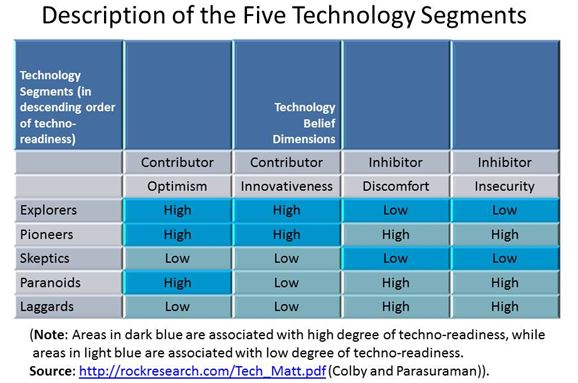Marketing Technology Innovations

The technology market is evolving at a rapid rate – current technologies are advancing and new ones are entering the marketplace. It is likely that the average customer, who is likely to be technology-shy, finds the onslaught of these technologies overwhelming. Those who do are likely to ignore the adoption of the technology.
In such a scenario, companies and marketers around the world tend to make a significant mistake – they use conventional marketing approaches, especially mass-advertising, in the hope that their potential customers will get convinced about their product or service, only to find that the results are disappointing.
Marketers of technology products do not try and understand the customers of their products. Traditional strategies do not work very well and a different approach is needed. In their 2007 book, Techno-Ready Marketing, A. Parasuraman and Charles L. Colby researched what they called ‘techno-ready consumers’ and identified five segments based on attitudes towards four technology beliefs – optimism, innovativeness, discomfort and insecurity. Obviously, optimism and innovativeness drive adoption and discomfort and insecurity inhibit it.
The five segments that they came out with are given below:
- Explorers. The Explorers are the most techno-ready segment; they are the first to adopt new technologies. They are extremely high on the drivers of technology readiness and very low in the inhibitors like discomfort and insecurity. In the U.S., as likely in other markets, they are younger, upmarket males and are likely to be working in technology professions. According to Parasuraman and Colby, Explorers constitute about 17% of the U.S. adult population.
- Pioneers. The Pioneers are highly motivated to adopt technology; however, they are also inhibited by a high level of insecurity and discomfort. They form 23% of the U.S. adult population and are the most ethnically diverse of any segment. They also tend to be young, middle class and success-oriented.
- Skeptics. The Skeptics are low in optimism and innovativeness but would eventually buy if they are convinced of the benefits. They represent 24% of the population, are likely to be of average age and fall in the upper middle class bracket.
- Paranoids. The Paranoids believe in technology’s benefits but are constrained by a high level of insecurity and discomfort. They tend to be in the lower income bracket and are more likely to be female. The Paranoids make up 18% of the population.
- Laggards. The least techno-ready segment, the Laggards have little motivation and a high level of resistance to using new technologies like the Internet and e-services. They are generally older and from the lower income category. They make up 18% of the population.
Parasuraman and Colby described the five technology segments as below:
Obviously, the different segments are at a different level of their ‘technology readiness’; given this, a marketer of an innovative product needs different strategies to reach the five segments. A one-size-fits-all mass media campaign is likely to be expensive and inefficient.
Let’s look at what a marketer should instead be doing:
- Technology evangelism. Apple has had a large number of evangelists even during its worst period. These people had a passion for Apple products mainly because they were so differentiated, superior in performance and easy to use. It was these evangelists that spread word about Apple to their friends and acquaintances. A company or brand must try and identify its Explorers or evangelists and get them to spread the word.
- Future-ready design. To especially convince the Pioneers, a company must launch a product that has a friendly design, has good support and can reassure the pioneers. The product should also be designed to run without problems for a longer period of time.
- Providing clear benefits. To the Skeptics, specifically, a company must clearly demonstrate the benefits that the consumer will derive from using its products or services.
- Market-stage pricing. Companies must have cheaper versions so as to attract the segments not totally convinced.
- Consumer-focussed design. This is a no-brainer – the simpler the better.
- Responsive service. The company MUST make it a point to offer all after-sales help to get the unsure consumers familiar with the usage of the product.
- Reassuring communications. This should include demonstrations, feedback, guarantees and help.
The Parasuraman-Colby study is closely related to the familiar Diffusions of Innovations theory. We all know that new ideas and technologies are adopted at different rates by different segments. The Diffusion of Innovations theory, popularised by Everett Rogers, argued that diffusion is a process by which an innovation is communicated in a social system. According to him, the four main elements that influence the spread of a new idea are the innovation itself, communication channels, time and a social system. Rogers presented the bell-shaped curve that consisted of innovators, early adopters, early majority, late majority and laggards. Most marketers know that they would need to follow different marketing strategies to appeal to the different segments.
In the path breaking book, Crossing the Chasm, Geoffrey Moore added a caveat to Rogers’ theory. Moore argued that, for disruptive or discontinuous technology products, there was likely to be a chasm between the early adopters of a product (the technology enthusiasts and visionaries) and the early majority (the pragmatists). The biggest challenge for a marketer of a disruptive innovation was to cross the chasm successfully. If the marketer failed in jumping that chasm, an innovation could flounder. Moore believed that the visionaries and pragmatists have very different expectations, and that it was necessary to have a different strategy to ‘cross the chasm’.
To conclude, what needs to be borne in mind is that consumers behave differently and adopt technology products at different rates. Following a standardised marketing strategy for all segments will not yield the results that one is expecting. Understanding the segments and developing tailor-made strategies for each is crucial.
Sources: Marketing Management by Philip Kotler; Wikipedia;
Technology Still Matters by Charles L. Colby and A. Parasuraman (http://rockresearch.com/Tech_Matt.pdf).
Visual courtesy:https://www.flickr.com/photos/wonderlane/

